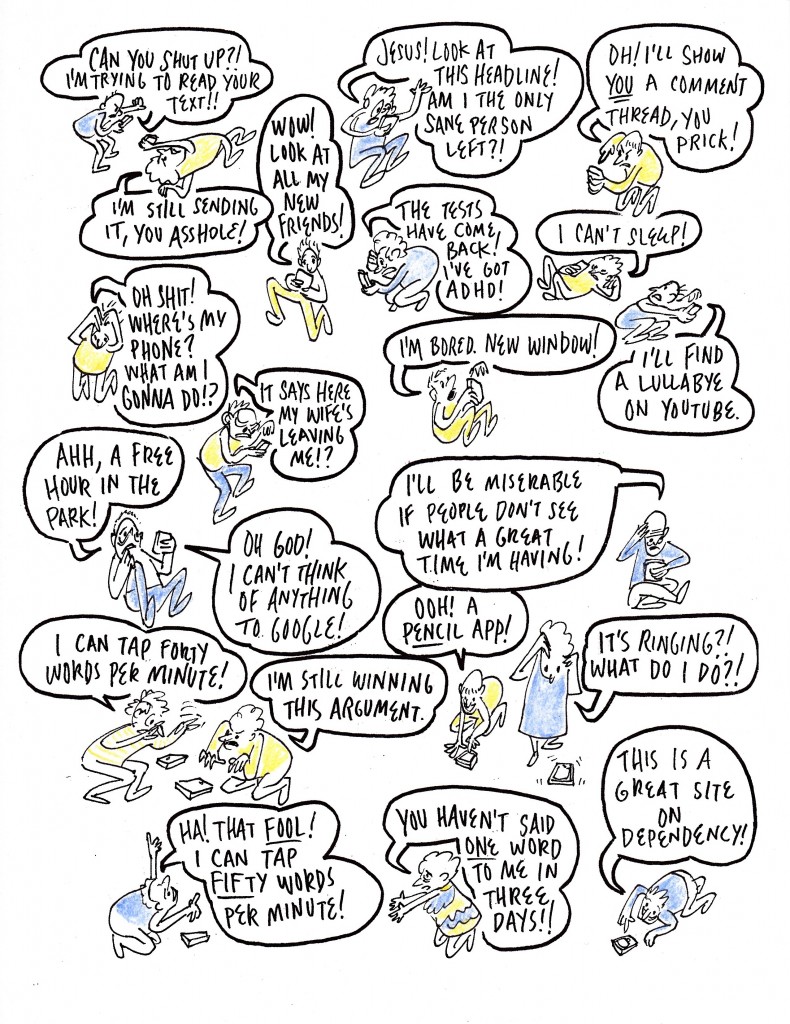hari s.
Shared posts
Femen Tunisia
Men Writing About Sexism (Well) and the Phenomenology of Doing Feminism
This recent article from the video game site Rock, Paper, Shotgun (RPS) is a well-written article about sexism in the gaming industry. (All quotes below are from the article.)

Game Developers Conference 2013
Even if you are not particularly interested in the intersection of feminism and video games, the article touches on an emotionally charged sub-topic: the phenomenology of social justice, a.k.a., the weird psychological and epistemological stuff that happens when we partake in these discussions.
“In having written about the subject of women and games over the years, I’ve received a significant amount of abuse. (I’m not going to fret about saying, “But of course not as bad as…”, because of course it’s not as bad as…) Most of the abuse I receive is lazy insults, and until recently I tended to assume them fairly innocuous. Some has been extreme, such as forum threads dedicated to associating my name with acts of child molestation to skew Google results, personal threats, and deeply personal insults. All of it has one purpose: to intimidate.”
It is reassuring and interesting when other people talk about the psychological effects of the backlash for talking about the -isms. Also, it’s impressive when a guy writes about the backlash he receives and I find myself genuinely sympathetic because he ‘gets it’.
“Generally the motivation for my writing any sort of polemic on RPS is because I’m angry about something – constructively angry about something a person should be angry about – and I want to see positive change. That’s what causes me to start typing, including this piece. But as I go along, those words creep in. “You’re just saying this to win the approval of others.” “You’re just trying to make girls like you.” “You think women need you to stand up for them.” And so on. They get to me. They’re getting to me right now. They’re evil spells, cast to insidiously infect.”
So I want to ask people about their own experiences with studying the -isms. I find the phenomenal and psychological aspects of engaging in social justice projects fascinating because I am going through a (for lack of a better term) paradigm shift in how I understand the norms of human action. In short, I’m shedding the worldview of pull-your-self-up-by-your-bootstraps atomized individualism that I grew up with and adopting a more…sociological?…understanding of human interaction. Things I used to hold as mantras I now see as false: It does matter what other people think of you; words can do more than break bones–they can rend souls; and there is no such thing as a self sufficient person–only a really privileged person who gets to enjoy the illusion of self sufficiency.
Have other people experienced things like this? Do you look back five or ten or twenty years in the past and realize you had a completely different understanding of how the world works? Do you struggle with managing the psychological aspects of using feminism in your work? (e.g. intimidation, isolation, social disapproval, wondering if you are insane or totally misled, etc.) I find these things creeping in whenever I write or say anything about the -isms. They get to me. It helps to know they get to other people, too.
Τζαμάρισμα στο μετρό
Συνέβη προ ημερών στο μετρό της Νέας Υόρκης: ένας τύπος (αργότερα θα μάθουμε ότι λέγεται Zack Mayer) παίζει βαρύτονο σαξόφωνο. Ένας άλλος τύπος (αργότερα θα μάθουμε ότι λέγεται Sapphire Adizes) τον ακούει και γουστάρει. Βγάζει το δικό του σαξόφωνο από τη θήκη και αρχίζει κι αυτός να παίζει. Πολύ σύντομα, το βαγόνι όλο χορεύει σε μια κόντρα αυτοσχεδιασμών που ξεκινάει από το Billy Jean και καταλήγει στην απρόβλεπτη ηχογράφηση του soundtrack μιας μέρας στη Νέα Υόρκη (ή, μάλλον, κάτω από τη Νέα Υόρκη).
Το πρώτο βίντεο έκανε θραύση — ανέβηκε στο youtube στις 31/3 και το έχουν ήδη δει ενάμισι εκατομμύριο άνθρωποι. O Sapphire έγινε αρχικά γνωστό ως the subway sax guy, ο τύπος με το σαξόφωνο στο μετρό. Την επόμενη μέρα, ανέβηκε στο youtube και το μέρος β’ του περίφημου jam session και ο Sapphire (καλιφορνέζος μουσικός, μέλος των Great Time Party, ο οποίος μόλις πρόσφατα εγκαταστάθηκε στη ΝΥ) βγήκε στις ειδήσεις. Απολαύστε λοιπόν μια ευλογημένη στιγμή:
Συνέντευξη του Sapphire εδώ.

Το dim/art στο facebook
Movement Atheism Ain't My Thing
Oh, I'm an atheist all right, and sometimes I'm even anti-theist; but I'm not really that inclined to take part in the larger movement as a whole. I used to participate in discussion forums, but I haven't done that for over a year. I used to read and lurk at a number of atheist and skeptic blogs, but I don't do much of that anymore either. I do some volunteer work with the local atheist group, but I've never marched or protested to publicize atheism or attach atheism to any political cause I care about. I've never had any interest in going to a skeptics' or freethought convention. I've pretty much kept my thoughts on atheism here in this quiet little corner of the intert00bs, satisfied enough with having a few dozen hits a day, and happy to let people stumble across this blog on their own instead of trumpeting its existence brazenly to the world.
Why? Well, a couple of reasons, really.
For one thing, I simply don't care that much about movement atheism. I am an atheist, but while I've spent a lot of time thinking and talking about atheism and sorting out just what that means in terms of my own life, it's largely been a personal thing rather than a public thing. Even with the personal being political, I don't consider my time here on this blog or on the fora at which I used to participate a form of activism. I keep up on atheism in culture, the news, and politics, but I don't usually add my voice. I'm just not that public about what I think. (Yeah I blog sometimes, but this blog gets minimal traffic, and I only have a couple hundred Twitter followers - and I'm fine with it being that way.)
For another, movement atheism is dogged by a pervasive misogyny that's proven difficult to even discuss, much less uproot and change. I've run into quite a bit of it online; in fact it's the main reason I stopped participating in online fora. I saw slut-shaming by anti-choice atheist men, saw endless reruns of "go make me a sammich" (from guys who thought it was hilarious and witty instead of the stupid, demeaning crap it really is), and almost grew deaf from the incessant whine of sexually frustrated atheist dudes who just couldn't understand how come women were stupid whores who wouldn't fuck entitled Nice GuysTM such as themselves. I saw myself and other atheist women ignored, dismissed, belittled, and generally treated like crap by way too many atheist men for daring to talk about "women's issues" or admit that we were feminists, or for committing the sin of noting that hey y'all, there's a lotta sexism in this movement and it needs to stop.
Dealing with that shit gets tiring at best, and it's still going on. (Witness the recent Elevatorgate fiasco, for instance.) I'm very glad to see that there are plenty of folks active and prominent in the atheist movement who get that it's a problem, and who spend a lot of bandwidth talking and arguing and calling it out and working to eliminate sexism where they find it: PZ Myers, Skepchick, Greta Christina, and many others. But that ain't my chosen fight.
I have always been a feminist, even before I was ever an atheist, and I will not take part in any movement, group, or organization where I don't feel welcome because of my gender. I left religion in part because it was demeaning to women, and I stay out of movement atheism in part because I don't feel welcome within it.
Women's issues are my priority, and feminist causes are where I feel most inclined to direct the bulk of my activism. And that's that.
The Little-Told Story of Elizabeth Keckley and Mary Todd Lincoln
 As the DVD of Spielberg’s latest epic, Lincoln, hit shelves last week, the Arena Stage in Washington, D.C. was telling a different Lincoln story: that of Mary Todd Lincoln and her dressmaker, former slave Elizabeth Keckley.
As the DVD of Spielberg’s latest epic, Lincoln, hit shelves last week, the Arena Stage in Washington, D.C. was telling a different Lincoln story: that of Mary Todd Lincoln and her dressmaker, former slave Elizabeth Keckley.
Keckley, author of Behind the Scenes, or, Thirty years a Slave, and Four Years in the White House, was born into slavery, bought her freedom, opened her own dressmaking shop and was eventually hired to be the personal dressmaker of the first lady. The tempestuous, intensely personal relationship between the two women—born of shopping trips, creative collaboration and the intimate hours spent in fittings— is the subject of Tazewell Thompson‘s new play, Mary T. and Lizzy K.
When Mary Todd Lincoln left the White House, she suffered a financial crisis. Thinking to help her former employer, Keckley wrote her book in which, as Thompson told the Ms. Blog,
She not only talked about her life as a girl, as a slave and the horrors that she suffered. She wrote about everything she witnessed in the White House. She wrote about Mary’s emotional swings, her spending habits, the outrageous arguments she had with the president, her insane jealousy.
Keckley’s plan was a total failure. Though the book created sympathy for Lincoln, Keckley was widely castigated. It did not sell and Lincoln never spoke to her friend again. Keckley died in a home for destitute women that she, in better times, had founded.
The 100-minute play imagines a conversation between the two women that never happened. It asks, “What if Keckley had come to visit Lincoln when she was confined to Bellevue Place?” (Keckley did, in fact, try numerous times to visit her former friend at the Illinois mental institution, but Lincoln never admitted her.) “What if they had made up?”

Keckley and Lincoln
From an opening scene in which Keckley is finally allowed to visit, Thompson takes the audience back in time, allowing them to witness some of the most intimate moments not only of the women’s friendship but also of Mary’s relationship with her husband. Years of research by Thompson inform the detail-rich characterizations, but on the page the play looks more like something by existentialist Samuel Beckett than an historical costume drama. That’s because, as Naomi Jacobson, who plays Lincoln, told Ms.,
I think he’s distilled [Mary] into a kind of essence. It’s a psychological, emotional portrait. There is a fierceness to her. There is a fighting spirit to her. She is a survivor.
Lincoln shares this fierceness with Keckley, who, unlike her mercurial employer, stays constant. Actor Sameerah Luqmaan-Harris says that, as an educated professional, Keckley was not the type of woman to feign inferiority with her white employer:
She has clawed her way out of the world of slavery and wants nothing to do with that world. (And not in a negative way—because she did actually quite a lot for free slaves who came through D.C. She created the Contraband Relief Association, because there was no like guidebook for a freed slave, and she saw that people didn’t know what to do, didn’t know where to go, had no support.) From what I’ve read about their relationship, her assertiveness was possibly why they worked so well together.
Nevertheless, the women for whom Keckley worked, Lincoln included, often failed to pay her for her work, and the sense of entitlement underlying Lincoln’s character manifests as racial privilege in one particularly fraught moment. Asked how she approaches playing a character so unaware of her privilege, Jacobson said,
I think these two women had a similar kind of spirit, but what is surrounding every particle of the atmosphere between these two women is the slave/owner relationship. In the air all around them is a given of inequality due to skin color. But then you’ve got Elizabeth giving Mary instruction. Elizabeth becomes not just a confidante friend but also a caretaker and mother. So these women are negotiating a whole set of relationships both spoken and unspoken.
Mary T. and Lizzy K. invites audiences to go on an historical journey as well as a fantastical one. In imagining, “What if these two friends had made up?” Thompson essentially asks us to imagine, “What if the end of the Civil War had represented true racial reconciliation?” But though the audience will find their hearts warmed by witnessing two friends reunited, the truth is never too far away. Abraham Lincoln will be shot. Mary will witness it. Keckley will die destitute. And the races, alas, will not yet have put aside all their differences 148 years later.
The play is well worth seeing. Reconciliation, after all, is a process, and storytelling can be an important part of it. If you’re in D.C., spend a night at Arena Stage imagining a different ending to the story.
To read more of the interviews with the artists, click here.
Photos of Sameerah Luqmaan-Harris as Keckley, Naomi Jacobson as Lincoln and Joy Jones as Ivy (Keckley’s apprentice) by Scott Suchman.
Baby Steps Toward Women’s Rights in Saudi Arabia
 Women are now allowed to ride bikes in Saudi Arabia —with a few tiny restrictions. They’re only allowed to bike if they are: in a restricted area, with a man, have covered their bodies completely under the rules of Islamic abaya, biking strictly for entertainment (not transportation) and staying away from places where groups of young men are gathered in order to “avoid harassment.”
Women are now allowed to ride bikes in Saudi Arabia —with a few tiny restrictions. They’re only allowed to bike if they are: in a restricted area, with a man, have covered their bodies completely under the rules of Islamic abaya, biking strictly for entertainment (not transportation) and staying away from places where groups of young men are gathered in order to “avoid harassment.”
But at least it’s a small step forward. After all, women still can’t drive in Saudi Arabia. There’s actually no law that specifically bans them from doing so, but drivers in the country need a license to operate a car, and women aren’t issued driver’s licenses. But hey, now they get to pedal in circles at a park!
In another recent move forward for women in Saudi Arabia—a place where clerics warn against females participating in sports so they don’t “lose their virginity” by tearing their hymens—they’re slowly gaining the right to play sports. On Saturday, local paper al-Watan Daily reported that women’s sports clubs are now being licensed. Before this point, women could only use exercise facilities if the Health Ministry designated them as “health centers.” This news comes after last summer’s Olympics, in which Saudi women participated for the first time.
Saudi Arabia is also getting ready for women to vote and run in municipal elections in 2015, as promised by the king.
Many women’s rights activists in the the country now feel their voices are finally being heard. After King Abdullah made the elections announcement, Hatoon al-Fassi, a women’s rights activist and university professor said,
We’re so excited. We believe it’s the response to our demands, the first step in our long struggle to get our rights.
And there’s more! Abdullah also said,
Because we refuse to marginalize women in society in all roles that comply with sharia, we have decided, after deliberation with our senior clerics … to involve women in the Shura Council as members.
As of now, 30 women have been sworn into the Shura Council (a formal advisory body that can propose laws to the king, but can’t pass laws), seen as a major stride in women’s rights. As for the future, activists are taking it one step at a time. Maybe one day soon they’ll be given permission to drive a car to run errands independently.
Sign here to urge the Saudi embassy and the United Nations to support drivers’ licenses for Saudi women.
Photo of Saudi woman in a traditional abaya by flickr user Nouf AL Kinani under Creative Commons 2.0
4 avril : Amina, 19 ans et 18 jours de captivité
Demain, sur toute la surface du globe, des milliers d’internautes vont penser à Amina. Cette jeune tunisienne de 19 ans, majeure donc, n’est plus libre de ses mouvements mais séquestrée et gavée de médicaments par sa famille, avec la complicité de la police et d’associations qui se taisent. Punie et retenue prisonnière. Sans avoir commis aucun crime, mais un simple péché aux yeux des puritains : deux photos d’elle torse nu, pour dire que son corps lui appartient : « Mon corps m’appartient, il n’est l’honneur de personne ». Depuis, ce corps ne lui appartient plus.
Il est d’abord été menacé par un prédicateur islamiste, Adel Almi. Craignant que son acte puisse « être contagieux et donner des idées à d’autres femmes », il souhaite qu’Amina soit punie « selon la charia ». Au minimum « 80 à 100 coups de fouet » voire « elle mérite d’être lapidée jusqu’à la mort ». Ses propos choquent de nombreux Tunisiens, mais pas au point de soutenir Amina ni de demander à la protéger. Elle se sent pourtant en danger et appelle à l’aide les FEMEN, avec qui elle est en contact depuis quelques jours. Elle doit se cacher chez des amis. Une branche de sa famille, l’inquiète tout particulièrement. Sur internet, une tante la décrit comme « psychopathe » et invite tout Tunisien à la dénoncer à la police. Plusieurs internautes Tunisiens prennent le relais, la signalent comme folle auprès de ses soutiens français, voire en voie d’être internée.
Pourtant, depuis des jours, la jeune femme tient bon et argumente. Elle donne des interviews, répond aux questions des journalistes et participe même à une émission très vue en Tunisie, où elle déjoue les critiques de manière très posée et structurée. Puis soudainement, Amina ne répond plus. Ni aux médias, ni à ses amis, ni à ses soutiens.
Un indice apparaît sur la toile. Le 18 mars, une vidéo la montre poussée dans un véhicule, garé à contresens dans l’avenue Habib Bourguiba, à quelques mètres seulement du ministère de l’intérieur. Des hommes agissant comme des policiers en civil forment un cordon. Amina a le bras tordu dans le dos par un proche, qui la pousse. L’attroupement laisse penser qu’il y a eu de la résistance. Où emmène-t-on ainsi Amina ? A l’hôpital psychiatrique ? En prison ? De force dans sa famille ? Pendant quelques jours, il faudra deviner. Puisque son téléphone est éteint et ne répond plus.
Quelques jours plus tard, un autre indice apparaît sur la toile. Dans une nouvelle vidéo, la tante d’Amina appelle « ses frères musulmans » à éradiquer les images dégradantes de sa nièce, accuse les Femen de complot, exhorte les religieux à éradiquer la drogue et la pornographie. Elle revendique surtout l’enlèvement, avec l’aide de policiers. Pour son bien, et surtout celui de « sa famille pieuse ». Ils la garderont le temps qu’il faudra pour qu’elle cesse d’être folle et redevienne normale. On la signale d’un hôpital psychiatrique de Tunis. Ses soutiens vérifient et ne trouvent rien.
La mobilisation, elle, a commencé. Depuis Londres, Mariam Namazie, une réfugiée iranienne, propose une journée internationale de soutien pour le 4 avril. Une vingtaine de personnes signent un appel à sa demande, dont Aliaa Magda Elmahdy, Kareem Amer, Jacek Tabisz, Nadia El-Fani, Richard Dawkins, Sundas Hoorain, Tarek Fatah, Taslima Nasrin, et moi même.
L’appel est repris par Luciano Barotto qui lance depuis l’Argentine, une pétition sur change.org et recueille plus de 100 000 signatures en quelques jours. Pendant ce temps, sur le site des FEMEN, des centaines de femmes et quelques hommes posent torses nus en soutien à Amina. D’abord massivement d’Amérique latine, puis du Golfe (Bahreïn), du Maghreb (Algérie, Maroc), mais aussi d’Egypte et d’Iran.
A Paris, l’ambassadeur aux droits de l’homme, François Zimeray, suit l’affaire de près. L’ambassade française à Tunis se renseigne, mais rien ne bouge. La diplomatie a beau dire mettre les « droit des femmes » au cœur de ses préoccupations, ce ne sont pour l’instant que des mots… Surtout lorsqu’il s’agit de la Tunisie. D’autant qu’une avocate connue, Bochra Bel Hadj Hmdia, dit représenter Amina et se veut rassurante. Elle est en vie, dans « sa famille », et « tout va bien ». Circulez, il n’y a rien à voir… Ses soutiens demandent à la voir pour le croire.
Le 27 mars, la journaliste de Marianne, Martine Gozlan, y parvient enfin. Les soutiens d’Amina l’ont mise en relation avec un ami à elle, ils connaissent son nom de famille, le numéro de téléphone de sa mère et la ville où on la détient. La journaliste se rend sur place et va convaincre cette mère de la laisser s’entretenir quelques minutes avec Amina. Elle en sortira bouleversée. Même sous haute garde et mise sous camisole chimique, la jeune femme confirme qu’elle ne regrette rien, qu’elle soutient les FEMEN, qu’elle a été enlevée, malmenée par un cousin violent, qu’elle n’est pas libre et qu’elle veut retourner à l’école. Sa famille n’y songe pas. Ils sont décidés à la garder.
Ils ne consentent qu’à la laisser sortir dehors quelques minutes par jour sous haute escorte à la demande de l’avocate, qui est enfin allée voir Amina, accompagnée de journalistes de Canal +. Ils ne l’apercevront que de loin, en pyjama et visiblement groggy.
Que font les défenseurs des droits de l’homme et des femmes en Tunisie ? Vont-ils se lever contre la séquestration d’une majeure avec l’aide de la police ? Ils le disent, mais à voix basse.
Hormis deux personnalités tunisiennes, Nadia El Fani et Raja Ben Slama, peu donnent publiquement de la voix pour exiger des explications.
Une tribune de Kareem Amer , bloggeur égyptien torturé sous Moubarak, s’émeut de tant de lâcheté. Sa signature est modifiée pour m’être attribuée par deux sites, dont un proche de l’Iran, dans le but de dénoncer une forme d’ingérence. Les éternels partisans du « charbonnier est maitre chez soi » se déchaînent. A partir de fausses informations et de rumeurs.
La campagne de soutien ne se laisse pas intimidée. Un site — Free Amina http://freeamina.blogspot.fr/2013/03/nouvelles-au-sujet-damina.html— se créée pour demander des comptes aux institutions tunisiennes, qui n’ont pas su protéger l’une de ses citoyennes. 34 000 courriers sont envoyés grâce une centaine de cybermilitants à travers le monde.
Le forum social mondial vient de s’ouvrir à Tunis. On espère un cri, un sursaut. Mais rien ne se passe. Des ateliers sont trop occupés à applaudir Tariq Ramadan ou les islamistes-capitalistes au pouvoir. D’autres ont mieux à faire. Après tout, qu’est-ce que la liberté d’expression et les droits des femmes… Tout va bien, on vous dit. Les portes parole de la famille prétendent même qu’elle retournera à l’école le 1er avril. Un mensonge de plus, qui sert juste à démobiliser
Nous sommes le 4 avril. Amina n’est pas à l’école mais toujours séquestrée. A l’appel de Maryam Namazie, plusieurs rassemblements vont être organisés devant les ambassades et consulats tunisiens : Malmo, Gotenburg, Stockholm, Bremen, Bonn, Frankfurt, London, Vancouver…
Les FEMEN ont également prévu d’agir. A leur façon. Radicale et provoquante. Qu’on aime ou non leur mode d’action, il faut bien avouer que la modération n’a pas payé… Certaines s’impatientent, voudraient frapper fort, et finiront sans doute par aller trop loin. Au risque de mettre en danger celle qu’elles veulent sauver.
J’apprends, en finissant ce texte, qu’une FEMEN d’origine tunisienne est allée brûler un drapeau salafiste devant… La Mosquée de Paris. Consternant choix sachant que la Mosquée de Paris est régulièrement attaquée par les salafistes en raison de sa modération. Mais ça n’est pas l’important.
Il faut regarder au-delà. Car le cas d’Amina dépasse largement le cadre d’un seul groupe ou d’un seul mode d’action.
Comme Aliaa avant elle, l’acte d’Amina a montré la voie à des milliers de femmes et résonne dans plusieurs régions à la fois. Ces femmes savent, désormais, combien leur corps est l’objet d’une guerre et donc une arme pour résister. Avec ou sans couronne de fleurs, sans forcément partager toutes les mêmes slogans, elles continueront, chacune à leur manière, une lutte engagée depuis des siècles… Contre la psychiatrisation et le musèlement des femmes libres. Que ce soit au nom de la tradition, de la religion ou de l’ordre établi. Un ordre dépassé, agonisant, et qui sera un jour aboli.
Le 4 avril, chacun à notre façon, soutenons Amina. 19 ans et déjà 18 jours de captivité.
Caroline Fourest
http://carolinefourest.wordpress.com
Classé dans:Articles et billets
Οι Σταυροφορίες από την πλευρά των Αράβων
Οι Σταυροφορίες από την πλευρά των Αράβων
Γράφει ο Γιάννης Σιατούφης
Με τη λέξη σταυροφορίες (crusades) εννοούμε τις εκστρατείες που έγιναν το Μεσαίωνα (8 εκστρατείες από το 1095 έως το 1291) από τους χριστιανούς της Δυτικής Ευρώπης με σκοπό την απελευθέρωση των Αγίων Τόπων. Κάθε φορά που θυμόμαστε τη λέξη σταυροφορία μας έρχονται στο νου διηγήσεις χριστιανών σταυροφόρων, ιστορικών και περιηγητών, σύμφωνα με τους οποίους οι εκστρατείες αυτές είχαν σαν σκοπό να απελευθερώσουν την Ιερουσαλήμ από τους άπιστους, έτσι ώστε οι χριστιανοί ελεύθερα να πηγαίνουν να προσκυνούν τους Άγιους Τόπους. Γι’ αυτό άλλωστε η λέξη «σταυροφορία» στο χριστιανικό λεξιλόγιο δηλώνει κάτι το θετικό, το συνασπισμό των ανθρώπων για καλό σκοπό.
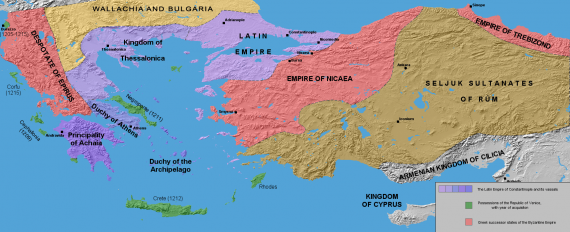
Η Λατινική και η Βυζαντινή Αυτοκρατορία μετά την Δ ‘Σταυροφορία. (περ. 1204)
Όμως οι καταστροφές, οι σφαγές (μουσουλμάνων, ορθόδοξων και εβραίων), το πλιάτσικο και η δημιουργία αποικιακών κρατών στην περιοχή τι σχέση έχουν με τον ωραίο και ρομαντικό σκοπό της απελευθέρωσης των Αγίων Τόπων; Οι βιαιότητες και οι ωμότητες ήταν τέτοιας έκτασης, ώστε ο φόβος και το μίσος, που προκάλεσαν στους Άραβες και στους άλλους μουσουλμανικούς λαούς της περιοχής, να διατηρείται μέχρι τις μέρες μας (π.χ. η εισβολή στο Ιράκ αποκλήθηκε από πολλούς Άραβες νέα σταυροφορία). Άλλωστε οι σταυροφορίες είναι η απαρχή των συγκρούσεων του χριστιανικού με το μουσουλμανικό κόσμο. Ενδιαφέρον έχει να δούμε πώς παρουσιάζουν οι Άραβες, αυτοί που ζούσαν εκεί και κατακτήθηκαν από τους σταυροφόρους, τις εκστρατείες αυτές και που οι απόψεις τους δε συμπίπτουν καθόλου με αυτές των Δυτικών.
Η 1η σταυροφορία (με την οποία θα ασχοληθούμε στο παρόν άρθρο) ξεκίνησε τυπικά με τη Σύνοδο του Κλερμόν το Νοέμβριο του 1095. Νωρίτερα (την άνοιξη του 1095) ο αυτοκράτορας του Βυζαντίου, Αλέξιος Α΄ Κομνηνός είχε ζητήσει βοήθεια από τον Πάπα, γιατί οι Σελτζούκοι Τούρκοι, με τη νίκη τους στο Μάτζικερτ το 1071, είχαν κατακτήσει τη Μ. Ασία. Ο Πάπας Ουρβανός Β΄ κήρυξε τον ιερό πόλεμο της Χριστιανοσύνης κατά των απίστων, για την απελευθέρωση των Αγίων Τόπων, υποσχόμενος σε όσους θα συμμετείχαν στην εκστρατεία ευλογία της Εκκλησίας, άφεση αμαρτιών, αναστολή των χρεών τους και προστασία της περιουσίας τους κατά το διάστημα της απουσίας τους. Όσοι πήγαιναν θα έραβαν ένα κόκκινο σταυρό στο ένδυμά τους. Η ανταπόκριση ήταν τεράστια, γι’ αυτό δίπλα από τους ιππότες –πολεμιστές υπήρχε πλήθος απλών, μάλλον ανεπιθύμητων, ανθρώπων

The Battle of Ager Sanguinis, 1337 miniature
Μετείχαν κυρίως Γάλλοι και Ιταλοί και όχι Άγγλοι, γιατί είχαν υποστεί τη Νορμανδική κατάκτηση το 1066, ούτε Ισπανοί, γιατί είχαν προβλήματα με τις αραβικές επιδρομές από την Αφρική, αλλά ούτε και Γερμανοί, γιατί είχαν εμφύλιες συγκρούσεις.
Οι Άραβες ιστορικοί και χρονικογράφοι μιλούν για «φράγκικο πόλεμο» ή «φράγκικες εισβολές». Ανάλογα με τις περιοχές, τους συγγραφείς και τις περιόδους, τους Δυτικούς και κυρίως τους Φράγκους οι Άραβες τους αναφέρουν με διαφορετικές λέξεις: Φαράνζ, Φαρανζάτ, Ινφράνζ, Ιφρανζάτ, Φρανζ. Οι σταυροφόροι εκμεταλλεύτηκαν το διχασμό που επικρατεί στους κόλπους του Ισλάμ, σχεδόν με την εμφάνιση της νέας θρησκείας, μεταξύ σουνιτών (Χαλιφάτο της Βαγδάτης) και σιϊτών (Φατιμίδες της Αιγύπτου). Ο Άραβας χρονικογράφος γράφει: «μερικοί λένε, πως όταν οι άρχοντες της Αιγύπτου είδαν την εξάπλωση των Σελτζούκων, φοβήθηκαν και ζήτησαν από τους Φράγκους να βαδίσουν εναντίον της Συρίας και να δημιουργήσουν ένα φράγμα μεταξύ αυτών και των μουσουλμάνων. Μόνο ο Θεός ξέρει την αλήθεια».
Ο πρώτος που δέχτηκε την επίθεση των σταυροφόρων ήταν ο Κιλίζ Αρσλάν, Σουλτάνος του Ρουμ (Σουλτανάτο της Νίκαιας). Διοικούσε μια μεγάλη περιοχή της Μ. Ασίας με πρωτεύουσα τη Νίκαια, μόλις τρεις μέρες δρόμο από την Κωνσταντινούπολη! Οι πρώτοι σταυροφόροι έφτασαν στην Πόλη με τον Πέτρο τον Ερημίτη.
Ο βυζαντινός αυτοκράτορας Αλέξιος Κομνηνός, επειδή φοβήθηκε για την ασφάλεια της Πόλης, αφού οι Φράγκοι λεηλατούσαν τη γύρω περιοχή, τους πέρασε όλους στην Ασία και τους εγκατέστησε στην Κιβωτό, στη νότια ακτή του κόλπου της Νικομήδειας (το σημερινό Ισνίκ). Νωρίτερα ο Αλέξιος υπέγραψε συμφωνία με τους σταυροφόρους ότι, όποια εδάφη της αυτοκρατορίας τα πάρουν από τους άπιστους, θα τα επιστρέψουν στη Βυζαντινή Αυτοκρατορία.

Όσοι πήγαιναν θα έραβαν κόκκινο σταυρό
Ο Κιλίζ Αρσλάν έμαθε από τους Τούρκους μισθοφόρους του βυζαντινού στρατού ότι έφτασαν χιλιάδες Δυτικοί στη Μ. Ασία. Ακούει παντού τους Φράγκους να κραυγάζουν ότι ήρθαν να εξολοθρεύσουν τους μουσουλμάνους, αν και βλέπει ότι καταστρέφουν και κλέβουν ακόμη και χριστιανικές εκκλησίες, αρπάζουν τις αποθηκευμένες σοδειές από τα ελληνικά χωριά και σφάζουν αλύπητα τους χωρικούς, που προσπαθούν να αντισταθούν. Ακόμη και παιδιά μικρής ηλικίας κάηκαν ζωντανά. Το 1096 καταφέρνει ο σελτζούκος σουλτάνος μία νίκη επί των σταυροφόρων, αλλά τον επόμενο χρόνο νέες ομάδες Φράγκων καταφθάνουν στη Μ. Ασία. Αυτοί εκμεταλλεύονται την απουσία του Κιλίζ Αρσλάν από τη Νίκαια και πολιορκούν την πόλη. Ο σελτζούκος σουλτάνος δεν προλαβαίνει και οι σταυροφόροι μπαίνουν στη Νίκαια, μια πόλη με περισσότερες βυζαντινές εκκλησίες παρά τζαμιά και την πλειονότητα των κατοίκων ελληνική. Οι Φράγκοι τη λεηλατούν, κατακρεουργούν τους άντρες και βιάζουν τις γυναίκες. Μετά από συνεννόηση Σελτζούκων Τούρκων και Βυζαντινών τη νύχτα της 18ης προς τη 19η Ιουνίου 1097 οι Βυζαντινοί με Τούρκους, ως επί το πλείστον στρατιώτες, παίρνουν την Πόλη από τους Φράγκους.
Οι σταυροφόροι αφήνουν τη Νίκαια και κατεβαίνουν νότια. Στο Δορύλαιο (το σημερινό Εσκί Σεχίρ) νικούν τους Σελτζούκους, πράγμα που σηματοδοτεί την κυριαρχία των Φράγκων στη Μέση Ανατολή για 2 αιώνες. Ο Ιμπν αλ-Καλανίσιμ, χρονικογράφος της Δαμασκού, αναφέρει μεταξύ άλλων για τη μάχη του Δορυλαίου: «Οι Φράγκοι κατέσφαξαν τον τούρκικο στρατό. Σκότωσαν, λεηλάτησαν και έπιασαν πολλούς αιχμαλώτους που τους πούλησαν για σκλάβους. Όλοι πανικοβλήθηκαν, ο τρόμος και η αγωνία πήραν μεγάλες διαστάσεις». Στις 21 Οκτωβρίου 1097 οι σταυροφόροι φτάνουν στην Αντιόχεια, μια πόλη που μπορεί να έχασε την παλιά της αίγλη, αλλά παρέμενε μια εντυπωσιακή πόλη, με 40.000 κατοίκους, περίμετρο φρουρίου 12.000 μέτρα και 360 πυργίσκους. Διοικητής της πόλης ήταν ο Γιαγκί Σιγιάν, ο οποίος διώχνει τους «νασσαρά» (οπαδοί του Ναζωραίου-έτσι αποκαλούσαν οι Άραβες τους χριστιανούς) από την πόλη και ετοίμασε την πόλη για μακροχρόνια πολιορκία.
Ο Ίμπν αλ-Αθίρ αναφέρει ότι κάποια στιγμή έγινε συμφωνία μεταξύ των Φράγκων και ενός «καταραμένου κατασκευαστή πανοπλιών», του Φιρούζ. Ο Φιρούζ ήταν κατασκευαστής πανοπλιών και υπεύθυνος για την υπεράσπιση των τειχών. Σύμφωνα με τον Άραβα χρονικογράφο ήταν Αρμένιος μουσουλμάνος, που κάποια στιγμή κατηγορήθηκε για μαύρη αγορά και πλήρωσε πρόστιμο.
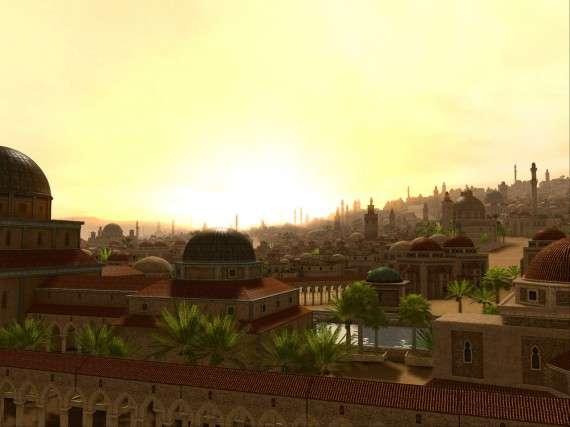
Στόχος των σταυροφόρων ήταν τα Ιεροσόλυμα, η τρίτη ιερή πόλη των μουσουλμάνων, μετά τη Μέκκα και τη Μεδίνα, γιατί σ’ αυτή την πόλη ο Θεός οδήγησε τον Προφήτη Μωάμεθ, για να συναντήσει τον Μωυσή και τον Ιησού.
Ζητώντας να εκδικηθεί, ο Φιρούζ ήρθε σε επαφή με τους Φράγκους πολιορκητές, τους οδηγεί στη νότια πύλη της Αντιόχειας. Οι Φράγκοι εισέβαλλαν στην πόλη στις 3 Ιουνίου 1098, ο Γιαγκί Σιγιάν την εγκατάλειψε και οι κάτοικοι παραδίδονται στο αίμα και τη φωτιά.
Το πιο τερατώδες όμως συνέβη στην πόλη Μάαρα στα νοτιοανατολικά της Αντιόχειας. Πριν έρθουν οι Φράγκοι, οι κάτοικοι ζούσαν ήρεμη ζωή υπό την εποπτεία του Ρεντβάν, ο οποίος βασίλευε στο Χαλέπι. Το καμάρι της Μάαρα ήταν το γεγονός ότι ήταν γενέτειρα του Αμπούν-Αλά αλ-Μααρί, από τις μεγαλύτερες μορφές της αραβικής λογοτεχνίας. Ο τυφλός αυτός ποιητής είχε το θάρρος να γράψει ότι: «οι κάτοικοι της γης χωρίζονται σε δύο κατηγορίες. Σ’ αυτούς που έχουν μυαλό και δεν έχουν θρησκεία, και σ’ αυτούς που έχουν θρησκεία, αλλά δεν έχουν μυαλό».
Οι κάτοικοι της Μάαρα ήρθαν σε επαφή με τον Μποεμόν, τον Φράγκο άρχοντα της Αντιόχειας και αυτός τους υποσχέθηκε να χαρίσει τη ζωή στους κατοίκους, αν φύγουν από τα κτίρια και σταματήσουν τον πόλεμο.
Στις 11 Δεκεμβρίου 1098 οι Φράγκοι μπαίνουν στην πόλη και δεν τηρούν την υπόσχεσή τους. Ο Ιμπν αλ-Αθίρ αναφέρει ότι «επί 3 μέρες πέρασαν τον κόσμο από την κόψη του σπαθιού, σκοτώνοντας περισσότερους από 100.000 ανθρώπους και αιχμαλωτίζοντας πολλούς». Μπορεί ο Άραβας χρονικογράφος να υπερβάλλει στον αριθμό, αφού η πόλη δεν είχε πάνω από 10.000 κατοίκους, αλλά η φρίκη που ακολουθεί άφησε ανεξίτηλη στη μνήμη των Αράβων την εικόνα των Φράγκων.
Ο Φράγκος χρονικογράφος Ραούλ ντε Καέν επιβεβαιώνει ότι « … στη Μάαρα οι δικοί μας έβραζαν σε χύτρες τους ανθρώπους και καταβρόχθιζαν τα παιδιά ψημένα στη σούβλα». Ο Άραβας χρονικογράφος Ουσάμα Ιμπν-Μουνκίντ θα γράψει: «όσοι άκουγαν για τους Φράγκους, όταν τους γνώρισαν, είδαν ότι αυτοί δε διαφέρουν από τα ζώα που έχουν το πλεονέκτημα του θάρρους και της θέρμης στον πόλεμο, αλλά τίποτε άλλο, όπως δηλαδή τα ζώα που έχουν μόνο την υπεροχή της δύναμης και της επιθετικότητας». Φόβο και περιφρόνηση προκάλεσαν λοιπόν οι Φράγκοι στο αραβικό κράτος της Συρίας, που ήταν ανώτερο σε πολιτισμό από τους Δυτικοευρωπαίους.
Είναι άδικη η παρουσίαση των Φράγκων ως «ανθρωποφάγων»; Όχι, επιβεβαιώνουν οι ίδιοι οι σταυροφόροι τα γεγονότα σε μια επιστολή που έστειλαν στον Πάπα τον επόμενο χρόνο: «ένας φοβερός λιμός έπληξε τη στρατιά της Μάαρα, που την εξανάγκασε στη σκληρή πράξη, να τραφεί με τα σώματα των Σαρακηνών». Όμως έγιναν και πράξεις από τους Φράγκους, που δεν δικαιολογούνται από την πείνα π.χ. οι Ταφούρ (ομάδες φανατικών Φράγκων) ξεχύνονταν στις κοιλάδες φωνάζοντας ότι θέλουν να τραγανίσουν κρέας σαρακηνό και το βράδυ μαζεύονταν γύρω από φωτιά για να καταβροχθίσουν τα θύματά τους. Ο Φράγκος χρονικογράφος Αλμπέρ ντ’ Άιξ έγραψε μεταξύ άλλων ότι: «οι δικοί μας όχι μόνο δεν ένιωθαν απέχθεια να τρώνε Σαρακηνούς, αλλά έτρωγαν ακόμα και σκύλους». Στις 13 Ιανουαρίου 1099 το μαρτύριο της πόλης Μάαρα τελείωσε, όταν οι Φράγκοι γκρέμισαν το τείχος και έβαλαν φωτιά σε κάθε σπίτι.

Gustave Dore
Στόχος των σταυροφόρων, όμως, ήταν τα Ιεροσόλυμα, η τρίτη ιερή πόλη των μουσουλμάνων, μετά τη Μέκκα και τη Μεδίνα, γιατί σ’ αυτή την πόλη ο Θεός οδήγησε τον Προφήτη Μωάμεθ, για να συναντήσει τον Μωυσή και τον Ιησού. Την Παρασκευή 5 Ιουλίου 1099 οι Φράγκοι κατέλαβαν την ιερή πόλη μετά από πολιορκία 40 ημερών. Περιγραφές αναφέρουν ξανθούς πολεμιστές με πανοπλίες να ξεχύνονται στους δρόμους με γυμνά σπαθιά αποκεφαλίζοντας άνδρες, γυναίκες και παιδιά. Οι επιζώντες μετέφεραν τα πτώματα στα χωράφια και τα έκαψαν και μετά εκτελούνταν ή πωλούνταν για σκλάβοι. Η τύχη των Εβραίων ήταν επίσης αποτρόπαιη. Αυτοί συγκεντρώθηκαν στην κύρια συναγωγή, για να σωθούν, ενώ οι Φράγκοι απέκλεισαν όλες τις εξόδους της εβραϊκής συνοικίας στα βόρεια της πόλης. Στοίβαξαν ξύλα και έβαλαν φωτιά. Όσοι δεν κάηκαν ζωντανοί σκοτώνονταν στην προσπάθειά τους να διαφύγουν.
Και οι Χριστιανοί δε γλύτωσαν. Συνέλαβαν τους Χριστιανούς ιερείς των ανατολικών χριστιανικών δογμάτων από τον Πανάγιο Τάφο και τους υπέβαλλαν σε βασανιστήρια μέχρι να καταφέρουν να μάθουν το μέρος και να αρπάξουν με τη βία το πολυτιμότερο κειμήλιο της ιερής πόλης, τον Τίμιο Σταυρό. Ο Άραβας χρονικογράφος Ιμπν αλ-Αθίρ σημειώνει: «οι Φράγκοι τήρησαν το λόγο τους και άφησαν τον Αιγύπτιο στρατηγό και τους άνδρες του να φύγουν νύχτα προς το λιμάνι της Ασκαλόν, όπου και εγκαταστάθηκαν. … Ο λαός της ιερής πόλης πέρασε από την κόψη του σπαθιού. Οι Φράγκοι έσφαζαν τους μουσουλμάνους επί μια βδομάδα. Στο τέμενος αλ-Ακσά σκότωσαν περισσότερους από 70.000 ανθρώπους». Και ο Ιμπν αλ-Καλανίσι αναφέρει ότι «γκρέμισαν όλα τα ιερά μνημεία και τον τάφο του Αβραάμ-ας αναπαύεται εν ειρήνη».
Οι Φράγκοι δεν είχαν τη μεγαλοψυχία, που είχαν δείξει οι Άραβες, όταν το 638 κατέλαβαν τα Ιεροσόλυμα από τους Έλληνες της βυζαντινής αυτοκρατορίας. Τότε ο Ομάρ έκανε την είσοδο στην πόλη πάνω σε άσπρη καμήλα και τον προϋπάντησε ο Πατριάρχης. Ο Χαλίφης σεβάστηκε τη ζωή και τα αγαθά όλων των κατοίκων και μάλιστα ζήτησε από τον Πατριάρχη ένα μέρος για να στρώσει το χαλί του και να προσευχηθεί. Αντίθετα οι Δυτικοί γιόρτασαν το θρίαμβό τους με έναν απερίγραπτο σφαγιασμό, καταστροφή και λεηλασία της Ιερής Πόλης.
ΒΙΒΛΙΟΓΡΑΦΙΑ
Εγκυκλοπαίδεια Πάπυρος larousse Britannica
Amin Maalouf «Οι σταυροφορίες από τη σκοπιά των Αράβων», Εκδόσεις Νέα Σύνορα-Λιβάνη, Αθήνα 1983.
Οι ψηφιακές απεικονίσεις είναι από εδώ: http://www.impulsedriven.com/crusaders
Jimi Hendrix on a gayageum
Luna Lee performs Jimi Hendrix's "Voodoo Chile" on a gayageum, a "traditional Korean zither-like string instrument" (Wikipedia). She freaking nails it. There's lots more if that strikes your fancy.
Voodoo Chile-Jimi Hendrix / Gayageum ver. by Luna
(via Reddit)
Legalized Marijuana Forcing Old Dogs To Learn New Tricks
Law enforcement agencies in Washington state are having to make lots of adjustments as the state implements a ballot initiative that legalized the use of marijuana. One surprise change has been the need to re-train dogs used for sniffing out illegal drugs.
» E-Mail This » Add to Del.icio.us
The Private Lives of Web Journalists
hari s.lol lol
"i 'll be miserable if people don't see what a great time i 'm having"
devidsketchbook: MYSTERIOUS TINY ROOMS BY MARC...

Artist Marc Giai-Miniet | Posted by devidsketchbook.com

Artist Marc Giai-Miniet | Posted by devidsketchbook.com

Artist Marc Giai-Miniet | Posted by devidsketchbook.com

Artist Marc Giai-Miniet | Posted by devidsketchbook.com

Artist Marc Giai-Miniet | Posted by devidsketchbook.com

Artist Marc Giai-Miniet | Posted by devidsketchbook.com

Artist Marc Giai-Miniet | Posted by devidsketchbook.com
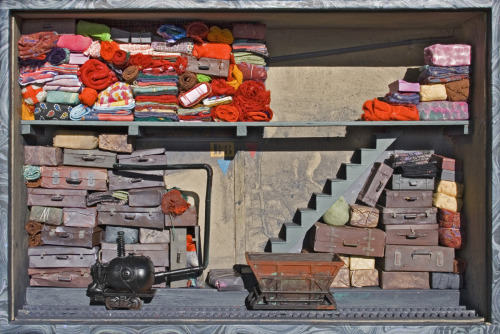
Artist Marc Giai-Miniet | Posted by devidsketchbook.com

Artist Marc Giai-Miniet | Posted by devidsketchbook.com
MYSTERIOUS TINY ROOMS BY MARC GIAI-MINIET
French artist Marc Giai-Miniet (Born in 1946 in Trappes) makes some of the most incredibly detailed (and disturbing!) dollhouses that we’ve ever seen. Marc started creating these disturbing shadowbox dioramas rather late in his career, recurring themes include libraries, furnaces, laboratories, submarines and intestine-like tubing in lonely, decaying spaces.
Libérez Amina ! Free Amina !
http://www.arabia5.com/1361/عاجل-الطفلة-إلي-عر-ات-روحها-علينا-كو-ر-بيها-بوها-و-خوها-هههه/
La dernière image que nous ayons d’Amina ? Une vidéo la montrant victime d’un enlèvement public, sous haute garde (notre témoin parle de policiers présents aux côtés de membres de sa famille), avenue Bourguiba… Depuis son téléphone est éteint et Amina a disparu.

Free Amina ! Libérez Amina !
La disparition d’Amina, l’activiste Femen Tunisienne prend un tour plus politique dans la mesure où la police tunisienne est impliquée dans l’enlèvement d’une citoyenne majeure.
Une campagne internationale d’envergure pour faire libérer Amina est lancée.
Le 24 mars 2013 à 9h30, 830 courriers ont été envoyés. 53 personnes se sont portées volontaires pour ne pas abandonner Amina.
Pour participer, il faut demander aux autorités tunisiennes et à leurs représentants des explications sur le kidnapping d’Amina.
http://freeamina.blogspot.fr/2013/03/adresses-qui-demander-des-explications.html
Par fax, par mail, par téléphone.
N’hésitez pas à relayer les actions, les pétitions, les articles et les tribunes sur Facebook et sur twitter #FreeAmina.
Voici un modèle de lettre en arabe
http://freeamina.blogspot.fr/2013/03/blog-post.html
Voici un modèle de lettre en français.
http://freeamina.blogspot.fr/2013/03/liberez-amina.html
Nous vous recommandons, si vous envoyez de nombreux mails de ne pas le faire de votre boite personnelle qui risque d’être hackée.
Envoyez nous toutes les informations utiles à freeamina@gmail.com (nouvelles adresses, nombre de courriers envoyés, actions…). Le site sera régulièrement mis à jour.
Groupe #FreeAmina
http://freeamina.blogspot.fr/2013/03/tribunes-pour-la-liberation-damina.html
http://freeamina.blogspot.fr/2013/03/actions-pour-la-liberation-damina.html
Classé dans:Articles et billets
Muslim Brotherhood against gender equality in Egypt
Create In-A-Pinch Pinhole Reading Glasses with Your Fingers
 If you're caught without your reading glasses, or you encounter some terrifically fine print on a box or contract, you have two options: curse your abnormal retina design, or pinch your fingers together. It's like adjusting the f-stop on your eyeballs. More »
If you're caught without your reading glasses, or you encounter some terrifically fine print on a box or contract, you have two options: curse your abnormal retina design, or pinch your fingers together. It's like adjusting the f-stop on your eyeballs. More » The One Woman Screwing Up North Dakota's Plan To End Abortion
Feedspot is one more good Google Reader alternative
Google has been in the news a lot recently, and much of it has been for all of the wrong reasons. The vast majority of that news has swirled around the decision the company made to kill its Reader program. Ghacks has discussed this in detail, providing a list of alternative apps and commentary on the backlash the Google decision has caused.
In my quest to find a replacement before the Google clock clicks down to zero I have tried both Feedly and The Old Reader. Both had their upsides and downsides. My latest attempt involves a service called Feedspot.
Unlike some of the ones out there, Feedspot is free. It is web-based and it can also import your Google Reader OPML file. To get started, you just need to sign up for an account., using your email address. The service prompts you to follow at least one of the feeds listed, which I suppose are partners and the revenue source for this model. These are not junk feeds though, so there is no need to panic on this. For instance, I chose to add National Geographic to my science section. I suppose you can unfollow later, but I will not because I actually like my choice.
After this, click the down arrow to the right of your name at the top of the screen and select "Import" to grab that XML file you took from Google Takeout. The import is almost instantaneous and you will be up and running in no time. However, it does not sync with Reader as services like Feedly do, so you will be face potentially thousands of "unread" stories.
There is an "Edit" button that allows you to arrange your feeds into categories, as I like to do. You can also follow people to see what they are sharing. There is a "Friend Activity" button at the top of the page -- it all looks very Facebok-like.
Conclusion
As far as the interface goes, Feedspot is by far my favorite service so far. It looks nice, works quickly and just appears slick overall. However, updates of new stories seem a bit slow. Overall, it is still the front runner to be my landing spot come July 1 when Google says goodbye to Reader.
The post Feedspot is one more good Google Reader alternative appeared first on gHacks Technology News | Latest Tech News, Software And Tutorials.
Goodfriday, 1613. Riding Westward
As in so much of Donne’s devotional verse, “Goodfriday” is structured around a “collision of the liturgy with the ego”, as Kirsten Stirling has put it. The speaker expresses guilt about travelling west on the day commemorating Christ’s crucifixion in the east, fulfilling personal obligations when he ought to be performing religious duties. However, awed by his contemplation of the crucifixion he reasons that he is facing the right way, and the direction of travel therefore directly enables the poem’s devotional climax. First, the poem explores the overwhelming nature of the crucifixion vision itself. To witness God’s death on earth would lead to a kind of paradoxical death difficult even to imagine (and Donne rhymes “dye” with “dye” at this point to powerful effect). How could a human being behold hands which could encompass infinity, or comprehend the “endlesse height” of heaven “Humbled below”? Given these visual impossibilities, the back of the head – said by Galen to be the seat of the memory – offers the more appropriate means of contemplation.more from Daniel Starza Smith at the TLS here.
amordragon: Since her death in 1979, the woman who discovered...

Since her death in 1979, the woman who discovered what the universe is made of has not so much as received a memorial plaque. Her newspaper obituaries do not mention her greatest discovery. […] Every high school student knows that Isaac Newton discovered gravity, that Charles Darwin discovered evolution, and that Albert Einstein discovered the relativity of time. But when it comes to the composition of our universe, the textbooks simply say that the most abundant atom in the universe is hydrogen. And no one ever wonders how we know.
Cecilia Payne-Gaposchkin, a truly extraordinary woman.
Egyptian Graffiti and Gender Politics: An Interview with Soraya Morayef
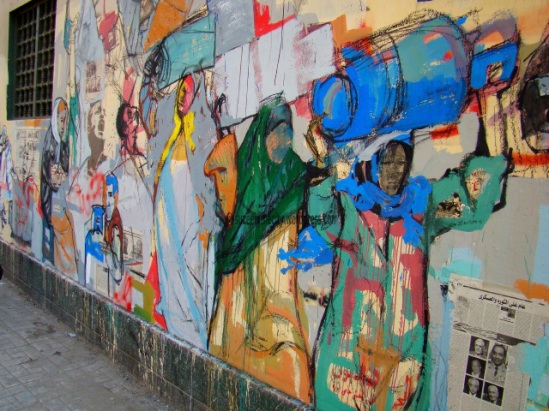
Hanaa El Degham, mural on the wall of the Lycée Français, Cairo. Copyright suzeeinthecity.wordpress.com.
Mickey Mouse is pulling apart a bomb: inside is the torso of George W. Bush, and they’re both looking perfectly happy about the whole thing. Soraya Morayef is taking a photo of the wall where these figures are painted, on a busy street in downtown Cairo, when a man walks up to her and asks her what the picture means.
‘I think that’s Mickey Mouse,’ I say helpfully.
‘Yes but what does it mean? And who is that man next to him?’
He’s bald with a graying walrus moustache, probably in his mid-forties, his full cheeks sweating as he fans at his pin-striped pink shirt.
‘I’m not quite sure,’ I say politely, wishing I could go back to my camera, but he appears adamant for an answer. ‘Maybe it’s a president? It could be George Bush.’
‘Yes but what is George Bush doing with Mickey Mouse? I like this picture, I walk past it every day, but I wish there’d be some writing explaining it so that I could understand.’
She is stuck between the wall and the man, who tells her he was in Tahrir Square (a stone’s throw away from where they are standing) every day of the uprisings, “one of the shabab of the revolution…”. Eventually, after he has given her his number, he leaves, and she recommences her task, cataloguing the street art in Cairo, a city in which graffiti has flourished since 2011, but where the wall may have been white-washed the next morning.
Morayef is a journalist and writer based in Cairo. Since June 2011 she has been blogging at suzeeinthecity.wordpress.com, where she posts images of street art, with captions and analysis. The same urgent questions — of graffiti and gender, intimidation and interpretation — resurface in a recent post, ‘Women in Graffiti: A Tribute to the Women of Egypt’, on the participation of women in making graffiti on the walls of Egyptian streets.

Sit El Banat, stencil tribute to the women who were beaten, dragged and stamped on by military forces in December 2011. Copyright suzeeinthecity.wordpress.com
The artists mentioned include Aya Tarek (“one of the pioneers of graffiti in Egypt”), Hend Kheera (“the first Egyptian graffiti artist to be profiled by Rolling Stone”), Bahia Shebab (an artist and art historian behind the project, A thousand times no), Mira Shihadeh, Laila Magued (more of her work here), the Nooneswa collective, and Hanna El Degham, whose work on the wall of the Lycee Morayef describes as “one of the most astounding street artworks I have seen in Egypt.” The article also includes images of the tributes — by artists Alaa Awad, Keizer, Zeft and Amr Nazeer, X4SprayCans and Ammar Abo Bakr — to Egyptian women, their role in the protests, works made in outrage at the men who have harrassed and attacked them.
The world has been fascinated by the explosion of graffiti in Egypt, and the walls have become signifiers for revolutionary desires, and the street a place where art makes demands of its public, everyday. The precariousness of this art makes Morayef’s catalogue of images necessary, and it has become the visual archive of an emancipatory politics, expressions of hope for a country in which women are not violated everyday.
The beginning of the project
“The project happened organically,” Morayef says, “I found it impossible to post images without context. I did it once and ended up having to explain it, it became an article. It wasn’t originally a project but a personal hobby of mine. I started taking photographs every day in April, May 2011, in the neighbourhood I lived in, where there was a faculty of fine arts.”
This was Zamalek, “where the art students were, so it made sense this should be the hunting ground. There was always new graffiti popping up and disappearing. I wasn’t aware of other people doing it, other citizen journalists. I thought, ‘ok, I’m the only one doing this. It was for my personal archive, I put it on Facebook and a friend said ‘can I share your album’. I said ‘I’ll put it on a blog and you can share it with your friends.’”
“Then I noticed graffiti appearing in different neighbourhoods. With every post it went from being fun to being an obssession. At some point it felt like a responsibility, but not in a negative sense. I started getting feedback from street artists. I would start to credit the photographs to the separate artists, the artists would start to contact me because they recognised I enjoyed what I was doing, that there was no ulterior motive to my job.”
“What was really great about the process was social media. These artists were uploading or tweeting. By following the top Twitter accounts I would find out about work I hadn’t heard of. All the artists have Twitter accounts, Facebook, so it was easy to access them without invading their privacy.”

Keizer, Fear Me, Government! Copyright suzeeinthecity.wordpress.com
“It reached the point where I could recognise the street, the aesthetic of the artist and figure it out. Ganzeer [who she interviews here] created this interactive Google map, this blog, where he enabled artists to upload images, and their location, so people like me could upload and tag them to the artist. But the artists I follow and I am aware of, I think they are the tip of the iceberg. They are twenty percent of the graffiti crowd.”
“You have activists who use graffiti, artists who use graffiti for a certain phase then stop because it became too trendy, artists who join because it is trendy … it’s hard to keep track … artists who sign their work, others who have no interest. These people, some of them I would only come across because I would drive by or walk by. In one or two cases they would reach out and say this does belong to me but I don’t want anyone to know.”
Sad Panda
“I was included in this crowd, giving me access to their personal lives and their information. Someone like Sad Panda, who has created this anonymous persona for the media so no one knows his real name. I wrote a blog about when he welcomed me to his house. He introduced himself as a friend of the artist. So I walk in and I have no idea who this kid is, cutting up a stencil of a panda, then meeting his mum, watching him as he works, that was a privilege.”

Ganzeer’s tank versus bike (with Sad Panda in melancholy pursuit), under the October 6th Bridge. Copyright suzeeinthecity.wordpress.com.
The origins of graffiti
“The general view is that it [graffiti] started with the revolution. I completely disagree with this. I’ve seen graffiti for as long as I remember liking it. Graffiti on school walls, on mosque walls, whether it’s patriotic or, like, I love my school. There’s an argument that the Muslim Brotherhood started using graffiti, usually in the impoverished neighbourhoods. There’s an argument that it started in Alexandria, and many of the artists who are known as the pioneers of graffiti, were working there as early as 2003/4.”
“One of the images I took [of a fresh work of graffiti next to an older piece] when I posted it on Twitter someone I knew messaged me and said ‘I took a photo of the graffiti next to it in 2005!’ So there’s been a change in attention, attention and participation. And a sudden focus on the international media.”
“It started from an urgent need [during the uprisings] we had no internet, no phone-line. We were cut off from the media, there was no one there … As the intention increased, there was the glamorisation of people in the revolution, especiall the youthful ones, many artists felt the need to participate. And there was suddenly an audience, for something which [before] would have been received negatively.”
The gender of graffiti artists
“The gender is still predominantly male. I have noticed – in the collective, the Mona Lisa Brigade, who are using graffiti for social initiatives – they have thirty percent members who are female. Apart from the female artists I mentioned on my blog there are perhaps a handful more.”
The Mickey Mouse encounter (read about the episode here)

Keizer, Mickey Mouse. Copyright suzeeinthecity.wordpress.com.
“Two years on I have a different perspective on it. It is a good example in Egypt [of the reaction to graffiti], when you are dealing with forty percent of the population being illiterate. It’s an environment to create art that would explain [itself] or be easily interpreted. The man’s conversation was a good example of – and I’m generalising – how we prefer to be told what it is rather than figuring it out.”
“We’ve lived under a dictatorship for so long, and it’s not only Mubarak, but Sadat and Nasser. We haven’t had a free space to come up with our own ideas. We are used to voting yes to everthing, so with every singly referendum people have voted yes. Because we just don’t understand saying no to our leaders.”
“When street artists make work which says no to military leaders, these are the works which are responded to most negatively. It was really interesting, you would have people getting really vocal: ‘you can criticise our leaders but the army is a red line.’ We couldn’t handle seeing our leaders, our heroes, our pharaos, criticised.
“That particular artist [Keizer – who she interviews here] was making graffiti which was really Western-influenced. I personally felt – and what I saw – was a certain confusion behind the messages. I think he received some flak from his peers. [The man on the street] would not recognise why George Bush is holding Mickey Mouse by the paw.”
“When you are dealing with traumatic events there is so much to work with. Why would you mystify the man on the street? The artist has since said that he is using Western graffiti to attack the elites, and that’s his theory. But he has since moved to making graffiti with Arabic language and Egyptian symbols. I have noticed a shift.”
Violence against women
“One artist [Zeft] made a stencil of Nefertiti with a gas mask. He distributed it via social media and said you can reuse this. It appeared on the Facebook page of Op Anti-Sexual Harassment, and you can see it in photographs of protests a few weeks back. This image appeared in Washington, Berlin and Gaza.”
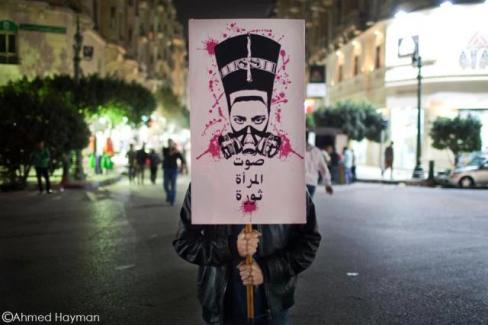
Zeft, Nefertiti mask. Copyright Ahmed Hayman.
“This was an example of one artist showing solidarity with women’s rights and rape. It became a symbol for social awareness campaigns. That’s a great success, but you are still dealing with a small segment of society. These artists, most of them are liberals, most of them are with the revolution. But the fact that women’s rights have been advocated by artists show that there has been a significant shift in awareness.”
The defacement of walls
“There was the Ganzeer tank versus bike grafiti, some of it was defaced. The artists are on the street, during the protest, sometimes the paint during the protest. I interviewed one artist during the protest: he was very upset, he said ‘this is the only thing I can do.’ So [working like this] is taking an artist from a sense of helplessness to a sense of responsibility.”
“This is the same thing the artists, Ammar Abo Bakr and Alaa Awad, who made the painting of the martyrs said. The guy and his friend made a mural on the AUC wall. They each spent two thousand Egyptian pounds, they said this is our way of paying them back. But it was so powerful and popular that alumni and members of the faculty circulated this petition asking the administration to stop the university from allowing government officials to paint over it. The artists came back and did a second paint.”
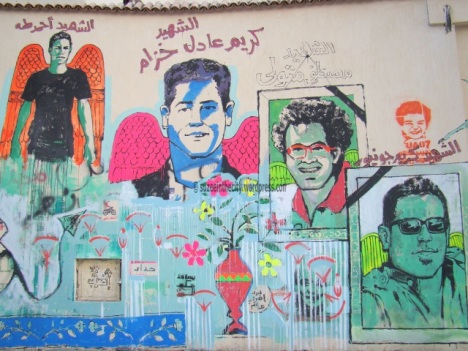
Painting of the Martyrs at AUC, Port Said. Copyright suzeeinthecity.wordpress.com.
“Then the government workers arrived. The baladiya – they are the bottom of the food chain, assigned to clean up – went down in the middle of the night. They actually had a line of soldiers protecting them as they cleaned off the graffiti. The reaction of the public was so heavy. You had street artists going on TV – who had previously avoided the media – who became very vocal in their criticism of the government. To the point that the prime minister had to release a statement.”
“I’m going to go ahead and say this was probably the most important moment in the history of graffiti. You had the prime minister, the second most important man in Egypt, having to apologise to a group of graffiti artists, who have been repeatedly criminalised.”
Soraya Morayef is currently pursuing a Master’s degree at Kings College London, as well as working with the Museum of Contemporary Art in Los Angeles on a series of videos documenting the graffiti scene in Cairo, Beirut, Libya and Palestine.
"Feminism has fought no wars. It has killed no opponents. It has set up no concentration camps,..."
hari s.and for free (and) safe sex !
- Dale Spender, Australian feminist scholar, teacher and writer (via a-thousand-desires)
"If you can’t laugh together in bed, the chances are you are incompatible, anyway. I’d rather hear a..."
- Richard Francis Burton (via h-o-r-n-g-r-y)
Comic Book Characters in the Style of Greek Art by Nicholas Hyde
Portland, Oregon-based artist Nicholas Hyde created a series of art prints that depict Marvel and DC comic book characters in the style of Greek art. They are available to purchase online at Society6 and Etsy.
via /Film
"A tradition in the cafés of Naples is to order a caffè sospeso – literally, a coffee “in..."
- Caffè sospeso - Wikipedia, the free encyclopedia
part, I bloody lost count
I’ve never claimed that every man who meets me likes me. Indeed, I don’t like every man I’ve met BUT there have been two men that rejected me, and I mean REJECTED me. One is an ancient history, the other one, oh God, keeps popping up time to time. Man, go and do something constructive; I don’t know, go and save the world or something. Just please stop popping up. Alternatively, go and get married.
I need to rename the blog, I’m going to call it ‘denizen’s fucked up love life’.
Reynard the Fox Reynard the fox is a trickster figure from...


Reynard the Fox
Reynard the fox is a trickster figure from European folklore, much like Coyote or Raven from certain First Nation traditions. Primarily written in a satyrical context to poke fun at the aristocracy or the clergy, Reynard uses wit and cunning to get the better of his enemies. His favourite ploy seems to be faking his death and planning posthumous revenge, which says something about the naivety of his antagonists, as it totally works a bunch of times. In the anthropomorphic kingdom ruled by Leo the Lion (with other inhabitants like Bruin the bear or Tybalt the cat) Reynard has many enemies that often team up to bring the folk hero down, but none are as formidable as his nemesis Isengrim the wolf.
Luckily, Reynard has castle Maleperdius to seek refuge in, that has so many trap doors and secret passages that you’d think it was designed by the same guy that did Wayne manor or that mansion from Clue.
Reynard became so popular in France especially that his name actually became the word for fox. The original word “goupil” was replaced by “renard” as farmers once believed that saying “goupil” brought bad luck.
The Last Post (for a while, anyway)
"In a world of lies the lie is not removed from the world by means of its opposite, but only by means of a world of truth." -- Franz Kafka, The Blue Octavo Notebooks
F.Y.I. I will continue to blog on literature and other things at Mindful Pleasures.
A Better Quality of Agony
hari s.for denizen / off / για τα κυματα

“Squid marinated in lemongrass and lime and chili flakes. Slices of salty haloumi cheese and lamb chops and sausages from Nicos, our local Greek Cypriot butcher…. We’d marinate a leg of lamb for two days in a mix of yogurt, almonds, pistachios, lots of spices, mint, and green chilies…. We’d buy greengages in August. Often they were perfect, not too yielding, but not unripe.”
The book in which the passage above appears contains other passages that speak of times in the garden, trips taken with family, children learning from their parents and vice versa, and moments of laughter and joy. In most books, these evocations of summertime ease and sweet familial conviviality would be a pleasure. In Sonali Deraniyagala’s memoir, “Wave,” they are among the most difficult things I’ve ever read. The reason: “Wave” is about Deraniyagala’s husband, her parents, and her two sons, aged seven and five, all of whom died in a single morning in December, 2004, when the tsunami hit the resort where they were holidaying in Sri Lanka. Deraniyagala herself was found spinning around in circles and almost deranged in a swirl of mud after the water receded. “Wave” is her account of that day, and of the years that followed.
...read more




